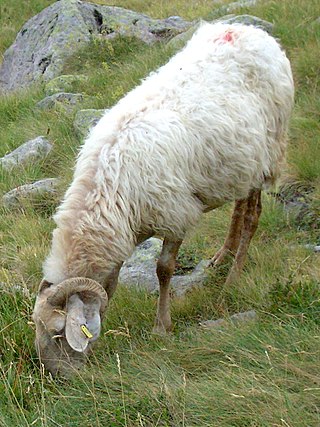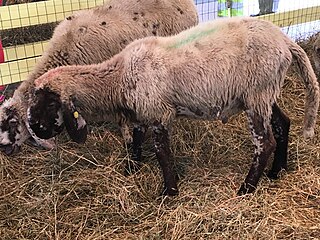The Corteno or Pecora di Corteno is a breed of sheep from the Val Camonica, in the province of Brescia in Lombardy, northern Italy. It is raised in the comune of Corteno Golgi, from which it takes its name, and in the neighbouring comuni of Edolo, Malonno and Paisco Loveno, all lying within the Comunità Montana di Valle Camonica. It is one of the forty-two autochthonous local sheep breeds of limited distribution for which a herdbook is kept by the Associazione Nazionale della Pastorizia, the Italian national association of sheep-breeders.

The Salernitano is an endangered Italian breed of horse. It originates from the floodplain of the Sele river, in the province of Salerno in southern Italy. It was formerly used as a military horse, but in the twentieth century became principally a sport horse.
The Grigio Siciliano or Asino Ferrante, is a breed of donkey from the Mediterranean island of Sicily in southern Italy. It is bred only on the island, in the provinces of Agrigento, Enna, Palermo, Ragusa and Syracuse. The conservation status of the Grigio Siciliano was listed as "critical" by the FAO in 2007. In 2012 it was not among the autochthonous donkey breeds of limited distribution recognised by the Ministero delle Politiche Agricole Alimentari e Forestali, the Italian ministry of agriculture and forestry. A recent census conducted by researchers at the University of Messina counted approximately 100 individuals between 4 months and 14 years old.
The Bagnolese is an Italian breed of domestic sheep from the area surrounding Bagnoli Irpino in the province of Avellino, in Campania in southern Italy. It takes its name from that of the town. It is raised principally in Irpinia, in the Monti Picentini, in the Monti Alburni, in the Piana del Sele and in the Vallo di Diano. It probably derives from the Barbaresca breed, and may also have been influenced by the Comisana. It is one of the forty-two autochthonous local sheep breeds of limited distribution for which a herd-book is kept by the Associazione Nazionale della Pastorizia, the Italian national association of sheep-breeders.

The Brigasca, French: Brigasque, is a breed of sheep from Liguria in north-west Italy and the département of Alpes-Maritimes in south-eastern France. It takes its name from the town of La Brigue, which was until 1947 in the Italian province of Cuneo. The Brigasca is raised in the provinces of Imperia and Savona in Italy, and neighbouring areas in France. It appears to have origins in common with the Frabosana and Delle Langhe breeds. It is one of the forty-two autochthonous local sheep breeds of limited distribution for which a herd-book is kept by the Associazione Nazionale della Pastorizia, the Italian national association of sheep-breeders.
The Ciavenasca is an Italian breed of small domestic sheep from the province of Sondrio, in Lombardy in northern Italy. It is raised in the mountainous terrain of the Val San Giacomo, the Val Bregaglia and the Valchiavenna, from which the name of the breed derives. It is raised only for meat; the wool is of very poor quality, and the milk is sufficient only for the lambs. It is one of the forty-two autochthonous local sheep breeds of limited distribution for which a herdbook is kept by the Associazione Nazionale della Pastorizia, the Italian national association of sheep-breeders.
The Cornella Bianca is a breed of domestic sheep from the Apennines of Emilia–Romagna in central Italy. It is raised principally in mountainous parts of the provinces of Bologna, Modena and Reggio Emilia, where it is transhumant. Some are also raised in the plains around Ferrara, Rovigo and Vicenza. It is found particularly in the comuni of Minerbio, Baricella and Malalbergo in the province of Bologna and Argenta in the province of Ferrara.

The Cornigliese or Corniglio is an Italian breed of domestic sheep from the Apennines of the province of Parma, in Emilia–Romagna in central Italy. It takes its name from the mountain town of Corniglio in that province; it may also be called Borgotarese after the town of Borgo Val di Taro which is about 40 km to the west. It is raised in the provinces of Bologna, Ferrara, Modena, Parma, Ravenna and Reggio Emilia.
The Finarda is a breed of large domestic sheep from the regions of Lombardy and Piemonte in northern Italy. It is heavy breed raised mainly for meat, although it also yields 4–6 kg of wool per year. It results from cross-breeding the Bergamasca and Biellese breeds. It is one of the forty-two autochthonous local sheep breeds of limited distribution for which a herdbook is kept by the Associazione Nazionale della Pastorizia, the Italian national association of sheep-breeders. However, in 2008 the herdbook was empty, and may in fact never have been activated. Most data for the breed dates from 1983.
The Frabosana is a breed of sheep from the valleys of the Monregalese, the area around Mondovì in the province of Cuneo, in Piemonte in north-west Italy. It takes its name from the comuni of Frabosa Soprana and Frabosa Sottana, and was once the most numerous sheep breed of Piemonte. It is raised in the Valle Gesso, the Valle Grana, the Valle Pesio, the Valle Vermenagna and the Valli Monregalesi, and in the Val Pellice. Two types are recognised within the breed, the Roaschino in the Ligurian Alps, and the slightly smaller Frabosana raised in the area of Mondovì. The Frabosana is one of the forty-two autochthonous local sheep breeds of limited distribution for which a herdbook is kept by the Associazione Nazionale della Pastorizia, the Italian national association of sheep-breeders.
The Garessina or Muma is a breed of small sheep from the Garessina, the area surrounding Garessio in the province of Cuneo, in Piemonte in north-west Italy. It is raised principally in the valleys of the Tanaro, its affluent the Negrone, and the Casotto; it is not raised commercially, but kept as a family sheep. It has been influenced by Spanish Merino and French Alpine breeds. The wool is of fine quality. The Garessina is one of the forty-two autochthonous local sheep breeds of limited distribution for which a herdbook is kept by the Associazione Nazionale della Pastorizia, the Italian national association of sheep-breeders.
The Garfagnina Bianca is a breed of small domestic sheep from the historic area of the Garfagnana, the mountainous northern part of the province of Lucca, in Tuscany in central Italy. It shares common origins with the Cornella Bianca, Massese and Zerasca. It is one of the forty-two autochthonous local sheep breeds of limited distribution for which a herdbook is kept by the Associazione Nazionale della Pastorizia, the Italian national association of sheep-breeders.
The Nostrana is a breed of sheep from the area of the Passo della Cisa, the Apennine pass which connects the comune of Pontremoli in the province of Massa Carrara, Tuscany, with that of Berceto in the province of Parma, in Emilia–Romagna. The Nostrana appears to be closely related to the Garfagnina Bianca, and probably also to the Cornigliese and Zerasca breeds. It is one of the forty-two autochthonous local sheep breeds of limited distribution for which a herdbook is kept by the Associazione Nazionale della Pastorizia, the Italian national association of sheep-breeders.
The Pomarancina is a breed of domestic sheep from Tuscany in central Italy. It is raised mainly in the comune of Pomarance, from which it takes its name, and in the neighbouring comuni of Castelnuovo di Val di Cecina, Montecatini Val di Cecina and Volterra, all in the province of Pisa; some are kept in other parts of Tuscany, in the provinces of Grosseto, Livorno, Lucca and Siena. It is one of the forty-two autochthonous local sheep breeds of limited distribution for which a herdbook is kept by the Associazione Nazionale della Pastorizia, the Italian national association of sheep-breeders.
The Saltasassi is an Italian breed of upland sheep, reared for meat. It originates in the provinces of Verbano Cusio Ossola and Novara in the northern part of Piemonte, in north-west Italy. It is one of the forty-two autochthonous local sheep breeds of limited distribution for which a herdbook is kept by the Associazione Nazionale della Pastorizia, the Italian national association of sheep-breeders.
The Trimeticcia di Segezia is a modern breed of domestic sheep from Puglia in southern Italy. It is named for the town of Segezia, a frazione of Foggia, where it was created at the Istituto Sperimentale per la Zootecnia, an experimental breeding station of the Ministero delle Politiche Agricole, Alimentari e Forestali, the Italian ministry of agriculture. "Trimeticcia" means "three-way hybrid": the breed was created by cross-breeding Gentile di Puglia ewes with French Île-de-France rams, and then crossing the resultant hybrid with Württemberger rams; the resulting stock was selectively bred for adaptation to the climate and conditions of the area. The range of the breed is principally the plain of the Tavoliere delle Puglie, but extends also into Molise. The Trimeticcia di Segezia is one of the forty-two autochthonous local sheep breeds of limited distribution for which a herd-book is kept by the Associazione Nazionale della Pastorizia, the Italian national association of sheep-breeders.
The Altamurana is an Italian breed of sheep from the province of Bari, in Puglia in southern Italy. It is of Asiatic, possibly Syrian, origin. It is raised mainly in the provinces of Bari and Foggia, and takes its name from the town of Altamura, in the Murge. It was formerly considered a triple-purpose breed, yielding meat, milk, and wool; it is now kept principally for milk production. It yields approximately 65 kg of milk per lactation, with an average of 7.5% fat and 6.5% protein.

The Chamois Coloured Goat, French: Chèvre chamoisée, German: Gämsfarbige Gebirgsziege, Italian: Camosciata delle Alpi, is an indigenous breed of domestic goat from Switzerland. It is distributed throughout Switzerland and in parts of northern Italy and Austria, and has been exported to other countries including France. There are two strains, a horned type from the Grisons or Graubünden in the eastern part of the country, and a hornless type from the former bezirk of Oberhasli and the area of Brienz and Lake Brienz in the Bernese Oberland in central Switzerland. In some countries the hornless variety may be considered a separate breed, the Oberhasli goat. The Swiss herd-book was established in 1930.
























